Analysis of data in sports: the interaction of scientists, clubs and federations. Lecture in Yandex
We hold events not only on the topics that we do ourselves. In February, we gathered experts on the use of machine learning in sports. It's amazing how many processes connect these two areas - data analysis and sports - and how many unsolved problems arise at the junction between them. This is a report by Dmitry Dagayev - Deputy Vice Rector of the Higher School of Economics.
- Today I will try to briefly talk about the tasks that are already solved with the help of data analysis in sports. We will see that it is the interaction of agents that is the key factor that allows solving these tasks.
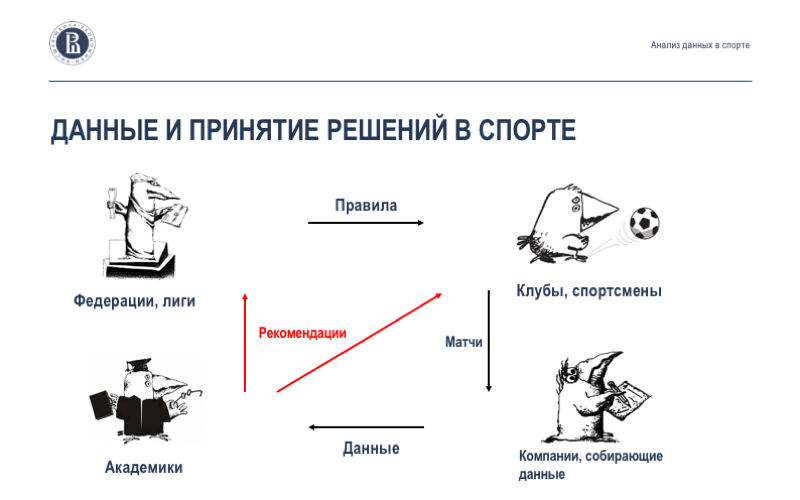
In general, the circulation of data in the sports industry is as follows. Firstly, there are sports federations and leagues that determine the rules of the game, according to which sports competitions and sports economics operate.
')
The problem is that these leagues, competitions, this economy is a very complex construction. And while making optimal decisions, of course, I want all of them to be optimal, but the federations face the need for accurate analysis. This is not always possible. Often, to get an accurate answer that allows you to maximize a particular value, you need to conduct a great computer simulation or some kind of regression analysis. Of course, a federation cannot always do this on its own.
The rules are defined, and clubs or individual athletes are forced to live by these rules. The next arrow also characterizes a certain range of problems. We played some kind of match or had a chess game. In theory, a huge amount of data can be extracted from a match. Until recently, data extraction encountered very serious problems. How to do it? The development of modern computer technologies has allowed, for example, in such strategic games as chess or go, to beat the most powerful athletes. And in such games as the simplest versions of checkers or poker, to find an actually exact solution.
Retrieving data in tasks that require image analysis is a rather expensive story. Therefore, the companies that are engaged in video filming of football and hockey matches began to appear on the market over the last 15–20 years and then successfully sell these data to clubs, federations or scientists.
Another problem is to analyze the data. This is where the academic community comes to the rescue. Very often, research departments exist either in the sports clubs themselves, or in companies that are engaged in data extraction, or in universities - as separate research centers. And they make recommendations based on the analysis of the data. So in the general case, this system is arranged.
Why analyze the data?
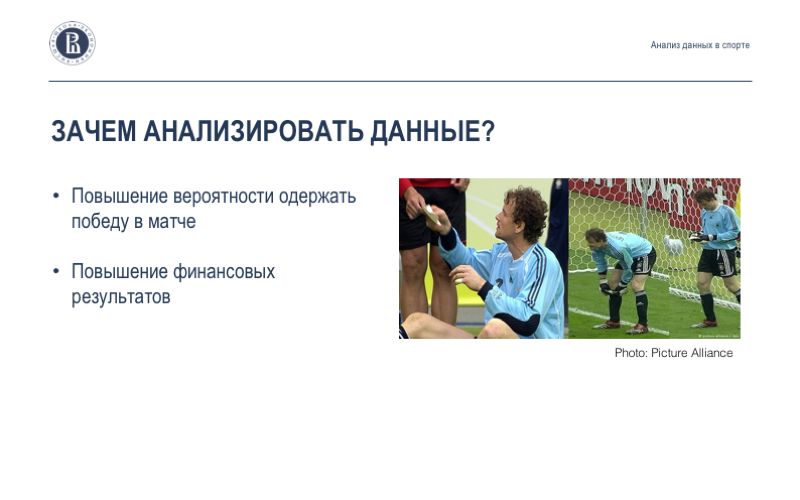
There are two global goals. For teams and athletes this allows them to increase the probability of winning in a single match. In this slide, Jens Lehmann. Perhaps the most famous example is when in 2006 the cheat sheet he took from his leggings allowed him to reflect two penalties from the Argentina national team and reach the next round of the World Cup.
The second task is generalized - improving financial results. Issues related to the increase in the sale of rights to broadcast matches. This requires an accurate analysis of consumer preferences, pricing. Here the data allows you to find the best answers.
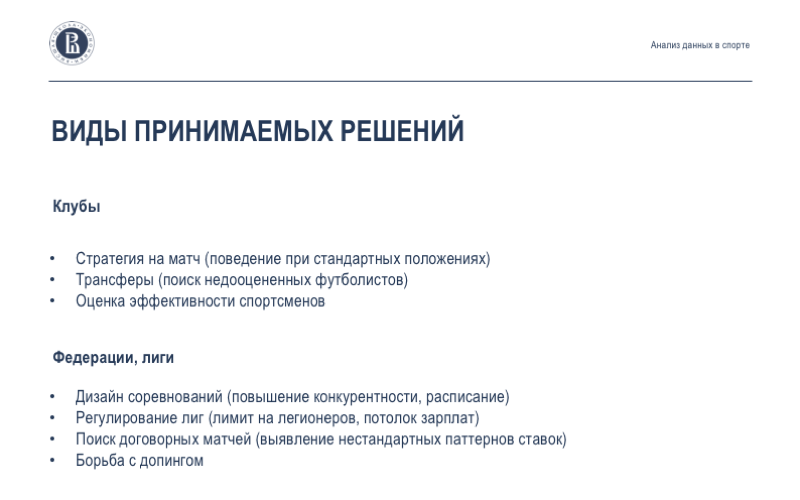
In general, clubs may be interested in analyzing their opponent's strategy in order to find the optimal answer in response to it.
In the early 2000s, Ignacio Palacios-Worth’s famous article “Professionals Play Minimax” appeared in which it turned out that, in fact, athletes who make a penalty shootout behave very much like theory predicts, and this allows clubs, analyzing data, find the best answers to the expected strategy of a player. Including if he deviates from the equilibrium strategy and tries to use some other strategy, he can successfully play against it.
Transfers, the search for underestimated athletes is also a very important task, in which many breakthroughs are now scheduled. Each club can formulate a separate request for the kind of player he needs. It is clear that there are a large number of athletes on the market, each of them has some transfer value, for each one can collect a large amount of statistical data on his performances in the recent past, but the problem is that it is not enough to look at the generalized statistics, you need to tweak these data with the needs of a particular club, so each club has to look for, including those players or hockey players who are best suited to its task.
Evaluation of the athlete's performance, how to arrange a contract for this athlete, how to find the optimal part of the bonuses that he needs to pay, how to do it so that he makes maximum efforts in each particular match. This task can be solved by evaluating the effectiveness of a separate set of actions that he performs during the match. This is also an important task in which the clubs are now interested.
From the point of view of federations or leagues, the tasks are slightly different. An important task is the design of competitions, how to make the league the most competitive. Because the higher the competition, the more attractive the league is to the viewers.
How to regulate the league, how to set optimal rules? What will lead to limits on foreign players? I would like not just to say that this will allow our team to successfully perform, but I want to try to simulate the situation and provide a more or less accurate answer based on predictions, simulations of this complex system, which in its complexity can be compared with the economy of a country.
Another problem that has been actively solved lately is the search for match-fixing, the market for illegal bets is growing at a frantic pace. If the rate market as a whole is already estimated at hundreds of billions of dollars, then the market for illegal rates, even if it takes up some share of it, still represents a large amount.
The fight against doping, today it is especially important. As it is possible, without being able to catch one or another chemical element, nevertheless, to make a prediction that the athlete uses doping - this analysis also helps.
Recently, a large number of investors have come to this market. The cost of solutions increases.
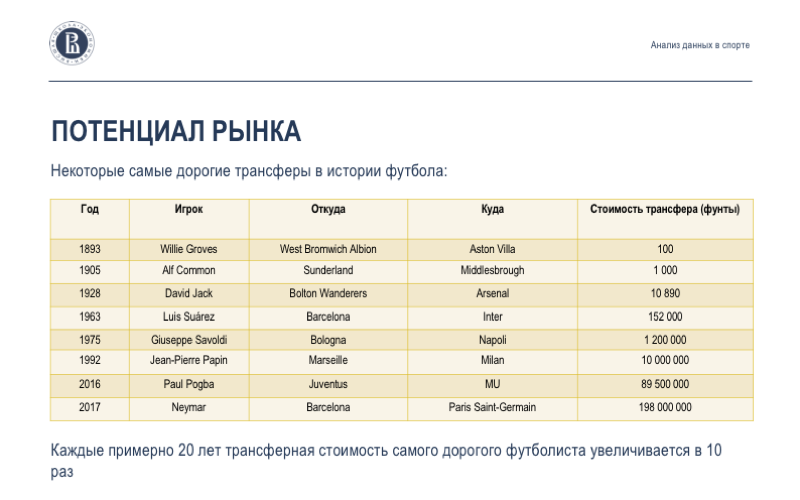
Here the volumes of the entire football market, the cost of the most expensive athletes in history. It can be seen that every approximately 20 years the cost of the most expensive transfer increased about 10 times. Even if we make allowances for inflation and changes in the real value of the pound, all the same, these growth rates substantially exceed the growth rates of the world economy and some other industries. There is an expectation that this trend will not stop. Rumor has it that right now compensation contracts, comparable to a billion dollars, are prescribed in the contracts of some football players. Let's see what will happen next.
The demand for accurate solutions that will avoid mistakes, including those measured by specific money, will increase. Therefore, we have something to do.

But not everything is so simple. There are several significant issues. The main thing is the underestimation of the importance of making exact decisions, decisions that are based not on intuition, but on exact calculation.
According to some experts, we are here behind Europe and the United States by about 10 years in terms of the introduction of sports analytics.
Now any Western club has a staff of analysts who not only collect data, but also analyze them in detail.
This problem creates a demand problem. This hinders the development of this market here in Russia.
This is not the only problem. There is a problem of supply, lack of qualified personnel. Unfortunately, while there are no specialized programs that provide education in the field of sports analytics, data analysis in sports. There are general programs for analyzing data, and lately there are many new, interesting and even free programs, but unfortunately, the market is not yet saturated, and this limits its growth. Hope everyone is ahead.
The third problem, which is now most successfully solved, is the high cost of data collection. To get high-quality complete data, you have to come to every league match, shoot it for professional video equipment. The last 10-15 years here there have been significant changes and breakthroughs.
I'll tell you about specific tasks.
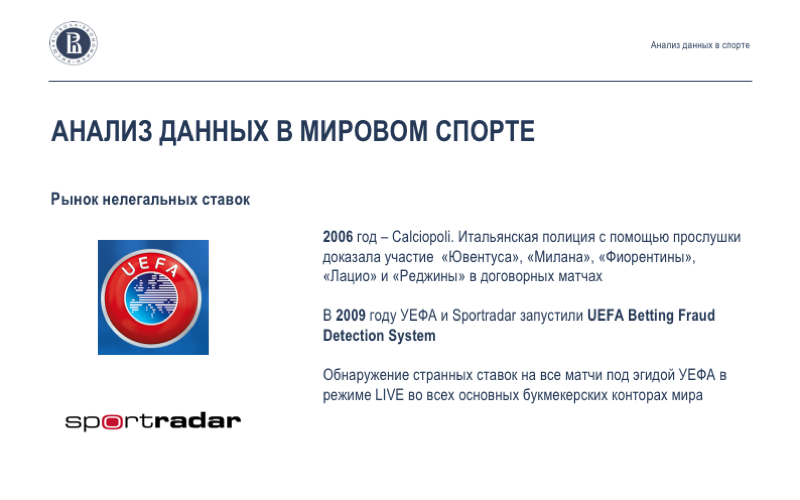
The first example is the market for illegal rates.
It all started around 2006, when the Italian police discovered through wiretapping that a substantial part of the Italian championship matches was in fact negotiable. Five clubs were significantly fined for participating in this outrage, several clubs were lowered in status, sent to lower leagues, some clubs lost some points in the national championship. “Juventus” lost the title of champion. Then it became clear that you need to somehow react. It is not always possible to grab the hand at the moment of collusion. It is necessary to find suspicious matches by indirect data.
In 2009, UEFA and Sportradar launched the UEFA Betting Fraud Detection System. She monitors all bets on matches that are held under the auspices of UEFA in all the largest bookmakers in the world. The system at the time for each match, when a bet that differs in size from the expected bet on such a match, when observations that are different from the regular trend are detected, a signal is generated at this point. And these signals are collected over a long period of time, and if it turns out that the signals of the same team very often receive such signals, logical suspicions immediately arise.
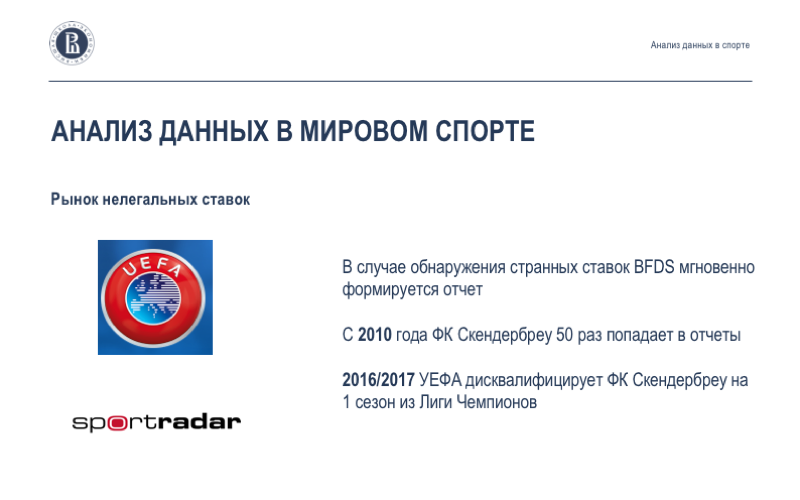
Here is the loudest case that occurred in recent years. Since 2010, the champion of Albania, the Skenderbrau football club, has been marked by more than 50 such strange signals. When the relevant authority inside UEFA analyzed these signals, Skenderbrau was disqualified first for one season from participating in European competitions, and now the issue of removing this club for more than 10 years is being discussed, as new data are revealed as a result of the investigation. Yesterday there was news that UEFA employees began to receive threats in connection with the investigation. Apparently, really something very suspicious. The UEFA president had to publicly speak out in defense of the employees who analyze the data and find these strange elements.
This is not about the fact that here in a legal sense, giving bribes. These are just signals that indicate that something is very wrong.
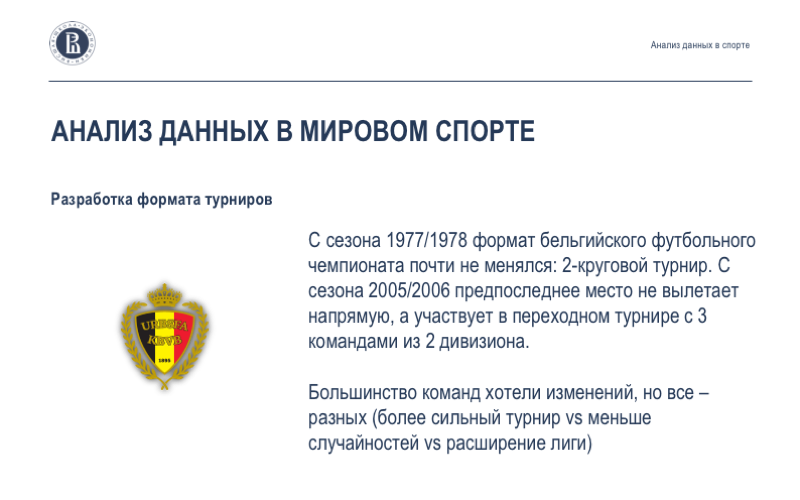
What else can sports federations be interested in? The Belgian Royal Football Association for a very long time, for almost 30 years, did not change the format of its championship. As a result, sports clubs felt they wanted something else. Some clubs wanted a stronger league, some wanted to expand the membership of the league. Then there was a request to change the format of the tournament.
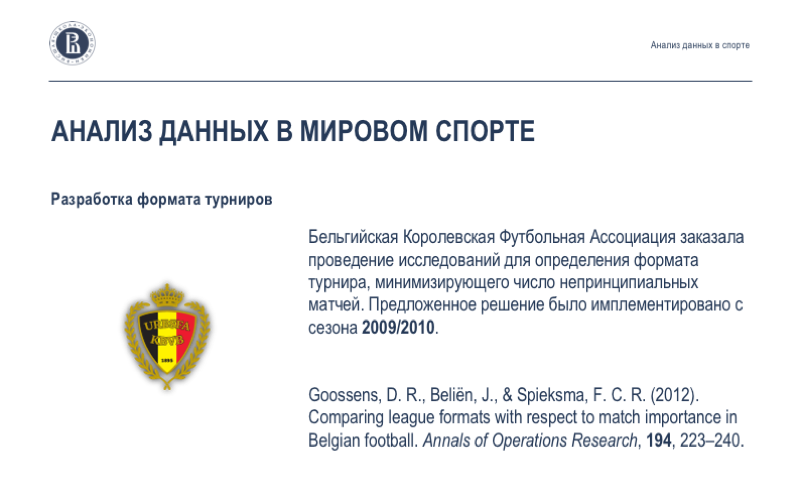
Officials wanted to minimize the number of insignificant matches. From their point of view, this was precisely what constrained the growth potential of the league, selling rights, and they ordered a number of researchers to compare the formats of several tournaments in order to minimize the most uninteresting matches, where both teams had already decided something, or where it was not interesting for anyone to play to win.
Goossens, Belon and Spixma analyzed several formats proposed by the federation, and in practice the solution was implemented, which they predicted would minimize the number of uninteresting matches. This is another example of the interaction of the academic community and the sports federation.
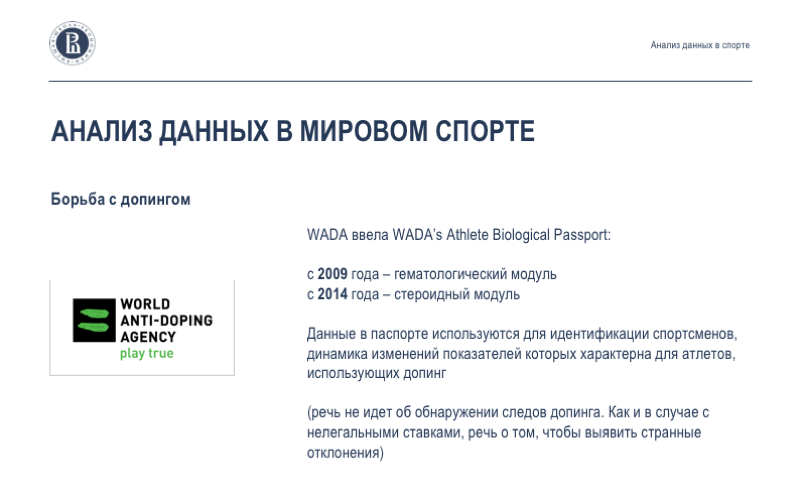
Another challenge - how WADA is engaged in the fight against doping. Of course, chemical analyzes of the samples are being carried out, but since 2009, WADA has begun to implement the athlete's biological passport. Every time when sports officers come to an athlete and take a urine or blood sample from him, the results of this analysis are recorded in a special biological passport. Since 2009, recorded blood counts, hematological control. Since 2014 - also urine indicators, steroid control. And the dynamic data in this passport is analyzed for the fact that the dynamics is different between athletes who use doping and who do not use it. Without chemical detection of traces of doping, it turns out to build predictions about who is suspicious, and these athletes are beginning to pay attention, more demands are made on them, officers come to them more often, other decisions are made.
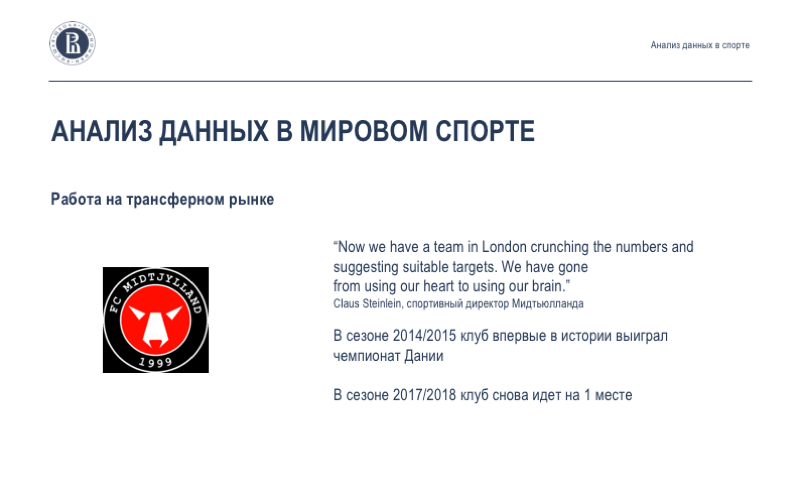
Go down to the level of clubs. The loudest story - at the sports club "Midtyulland." The sports director of this club said that “it’s time for us to move from decision making with the help of our heart to decision making with the help of our brain.”
The football club actually owns a whole department of analysts who sit in London, and any strategic, managerial decision that the club makes is based on data analysis. Not having a significant budget, the club, nevertheless, finds players who are the most productive and successful in the strategic objectives of this club.
In 2014–2015, for the first time in history, the club became the champion of Denmark, in the current season it comes again in the first place, and the entire sports and analytical world actively watches what innovations the club brings to making decisions that help improve results.
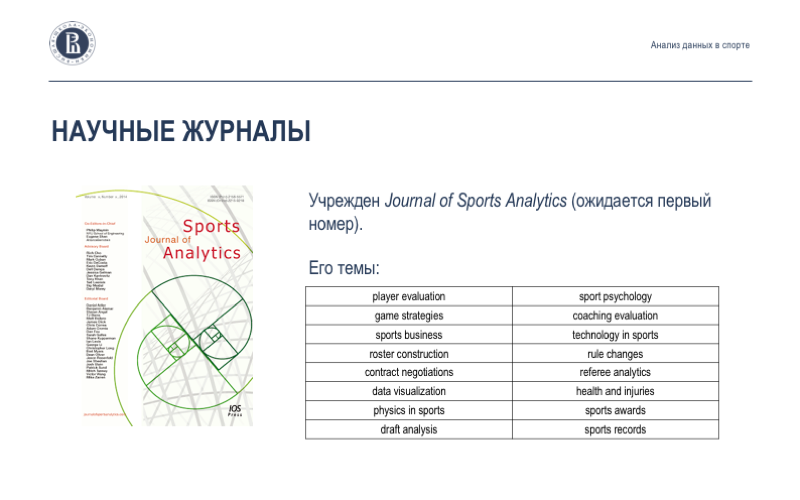
About the academic side of this market. Since I represent the university, this is most interesting for me.
Now there is a specialized journal of Journal of Sports Analytics. The scope of tasks that are interesting to solve exclusively for the academic community, even in isolation from the market, is very large.
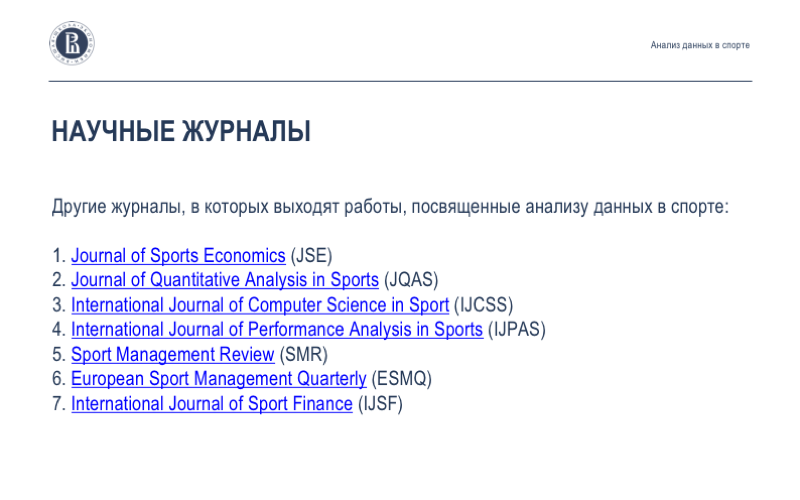
References:
There are about seven other journals that publish data analysis research. Computer science magazines, economics, management. And recently the ratings of these magazines are beginning to increase significantly.

Scientific conferences. About 15 years ago, large conferences began to appear, which are sponsored by large corporations, universities of world renown. I want to advertise a conference on the economics of football organized by the HSE and NES, which will be held in Moscow as part of the World Cup from July 9 to July 11. We will be glad to see you as listeners, and if you have interesting works that can be presented there, write to me too, we will try to include them in the conference program.
I hope our communication will reveal common points of contact. Let's hope that the analysis of data in sports will develop and correspond to the growth rate of the market, which we have already seen.
- Today I will try to briefly talk about the tasks that are already solved with the help of data analysis in sports. We will see that it is the interaction of agents that is the key factor that allows solving these tasks.

In general, the circulation of data in the sports industry is as follows. Firstly, there are sports federations and leagues that determine the rules of the game, according to which sports competitions and sports economics operate.
')
The problem is that these leagues, competitions, this economy is a very complex construction. And while making optimal decisions, of course, I want all of them to be optimal, but the federations face the need for accurate analysis. This is not always possible. Often, to get an accurate answer that allows you to maximize a particular value, you need to conduct a great computer simulation or some kind of regression analysis. Of course, a federation cannot always do this on its own.
The rules are defined, and clubs or individual athletes are forced to live by these rules. The next arrow also characterizes a certain range of problems. We played some kind of match or had a chess game. In theory, a huge amount of data can be extracted from a match. Until recently, data extraction encountered very serious problems. How to do it? The development of modern computer technologies has allowed, for example, in such strategic games as chess or go, to beat the most powerful athletes. And in such games as the simplest versions of checkers or poker, to find an actually exact solution.
Retrieving data in tasks that require image analysis is a rather expensive story. Therefore, the companies that are engaged in video filming of football and hockey matches began to appear on the market over the last 15–20 years and then successfully sell these data to clubs, federations or scientists.
Another problem is to analyze the data. This is where the academic community comes to the rescue. Very often, research departments exist either in the sports clubs themselves, or in companies that are engaged in data extraction, or in universities - as separate research centers. And they make recommendations based on the analysis of the data. So in the general case, this system is arranged.
Why analyze the data?

There are two global goals. For teams and athletes this allows them to increase the probability of winning in a single match. In this slide, Jens Lehmann. Perhaps the most famous example is when in 2006 the cheat sheet he took from his leggings allowed him to reflect two penalties from the Argentina national team and reach the next round of the World Cup.
The second task is generalized - improving financial results. Issues related to the increase in the sale of rights to broadcast matches. This requires an accurate analysis of consumer preferences, pricing. Here the data allows you to find the best answers.

In general, clubs may be interested in analyzing their opponent's strategy in order to find the optimal answer in response to it.
In the early 2000s, Ignacio Palacios-Worth’s famous article “Professionals Play Minimax” appeared in which it turned out that, in fact, athletes who make a penalty shootout behave very much like theory predicts, and this allows clubs, analyzing data, find the best answers to the expected strategy of a player. Including if he deviates from the equilibrium strategy and tries to use some other strategy, he can successfully play against it.
Transfers, the search for underestimated athletes is also a very important task, in which many breakthroughs are now scheduled. Each club can formulate a separate request for the kind of player he needs. It is clear that there are a large number of athletes on the market, each of them has some transfer value, for each one can collect a large amount of statistical data on his performances in the recent past, but the problem is that it is not enough to look at the generalized statistics, you need to tweak these data with the needs of a particular club, so each club has to look for, including those players or hockey players who are best suited to its task.
Evaluation of the athlete's performance, how to arrange a contract for this athlete, how to find the optimal part of the bonuses that he needs to pay, how to do it so that he makes maximum efforts in each particular match. This task can be solved by evaluating the effectiveness of a separate set of actions that he performs during the match. This is also an important task in which the clubs are now interested.
From the point of view of federations or leagues, the tasks are slightly different. An important task is the design of competitions, how to make the league the most competitive. Because the higher the competition, the more attractive the league is to the viewers.
How to regulate the league, how to set optimal rules? What will lead to limits on foreign players? I would like not just to say that this will allow our team to successfully perform, but I want to try to simulate the situation and provide a more or less accurate answer based on predictions, simulations of this complex system, which in its complexity can be compared with the economy of a country.
Another problem that has been actively solved lately is the search for match-fixing, the market for illegal bets is growing at a frantic pace. If the rate market as a whole is already estimated at hundreds of billions of dollars, then the market for illegal rates, even if it takes up some share of it, still represents a large amount.
The fight against doping, today it is especially important. As it is possible, without being able to catch one or another chemical element, nevertheless, to make a prediction that the athlete uses doping - this analysis also helps.
Recently, a large number of investors have come to this market. The cost of solutions increases.

Here the volumes of the entire football market, the cost of the most expensive athletes in history. It can be seen that every approximately 20 years the cost of the most expensive transfer increased about 10 times. Even if we make allowances for inflation and changes in the real value of the pound, all the same, these growth rates substantially exceed the growth rates of the world economy and some other industries. There is an expectation that this trend will not stop. Rumor has it that right now compensation contracts, comparable to a billion dollars, are prescribed in the contracts of some football players. Let's see what will happen next.
The demand for accurate solutions that will avoid mistakes, including those measured by specific money, will increase. Therefore, we have something to do.

But not everything is so simple. There are several significant issues. The main thing is the underestimation of the importance of making exact decisions, decisions that are based not on intuition, but on exact calculation.
According to some experts, we are here behind Europe and the United States by about 10 years in terms of the introduction of sports analytics.
Now any Western club has a staff of analysts who not only collect data, but also analyze them in detail.
This problem creates a demand problem. This hinders the development of this market here in Russia.
This is not the only problem. There is a problem of supply, lack of qualified personnel. Unfortunately, while there are no specialized programs that provide education in the field of sports analytics, data analysis in sports. There are general programs for analyzing data, and lately there are many new, interesting and even free programs, but unfortunately, the market is not yet saturated, and this limits its growth. Hope everyone is ahead.
The third problem, which is now most successfully solved, is the high cost of data collection. To get high-quality complete data, you have to come to every league match, shoot it for professional video equipment. The last 10-15 years here there have been significant changes and breakthroughs.
I'll tell you about specific tasks.

The first example is the market for illegal rates.
It all started around 2006, when the Italian police discovered through wiretapping that a substantial part of the Italian championship matches was in fact negotiable. Five clubs were significantly fined for participating in this outrage, several clubs were lowered in status, sent to lower leagues, some clubs lost some points in the national championship. “Juventus” lost the title of champion. Then it became clear that you need to somehow react. It is not always possible to grab the hand at the moment of collusion. It is necessary to find suspicious matches by indirect data.
In 2009, UEFA and Sportradar launched the UEFA Betting Fraud Detection System. She monitors all bets on matches that are held under the auspices of UEFA in all the largest bookmakers in the world. The system at the time for each match, when a bet that differs in size from the expected bet on such a match, when observations that are different from the regular trend are detected, a signal is generated at this point. And these signals are collected over a long period of time, and if it turns out that the signals of the same team very often receive such signals, logical suspicions immediately arise.

Here is the loudest case that occurred in recent years. Since 2010, the champion of Albania, the Skenderbrau football club, has been marked by more than 50 such strange signals. When the relevant authority inside UEFA analyzed these signals, Skenderbrau was disqualified first for one season from participating in European competitions, and now the issue of removing this club for more than 10 years is being discussed, as new data are revealed as a result of the investigation. Yesterday there was news that UEFA employees began to receive threats in connection with the investigation. Apparently, really something very suspicious. The UEFA president had to publicly speak out in defense of the employees who analyze the data and find these strange elements.
This is not about the fact that here in a legal sense, giving bribes. These are just signals that indicate that something is very wrong.

What else can sports federations be interested in? The Belgian Royal Football Association for a very long time, for almost 30 years, did not change the format of its championship. As a result, sports clubs felt they wanted something else. Some clubs wanted a stronger league, some wanted to expand the membership of the league. Then there was a request to change the format of the tournament.

Officials wanted to minimize the number of insignificant matches. From their point of view, this was precisely what constrained the growth potential of the league, selling rights, and they ordered a number of researchers to compare the formats of several tournaments in order to minimize the most uninteresting matches, where both teams had already decided something, or where it was not interesting for anyone to play to win.
Goossens, Belon and Spixma analyzed several formats proposed by the federation, and in practice the solution was implemented, which they predicted would minimize the number of uninteresting matches. This is another example of the interaction of the academic community and the sports federation.

Another challenge - how WADA is engaged in the fight against doping. Of course, chemical analyzes of the samples are being carried out, but since 2009, WADA has begun to implement the athlete's biological passport. Every time when sports officers come to an athlete and take a urine or blood sample from him, the results of this analysis are recorded in a special biological passport. Since 2009, recorded blood counts, hematological control. Since 2014 - also urine indicators, steroid control. And the dynamic data in this passport is analyzed for the fact that the dynamics is different between athletes who use doping and who do not use it. Without chemical detection of traces of doping, it turns out to build predictions about who is suspicious, and these athletes are beginning to pay attention, more demands are made on them, officers come to them more often, other decisions are made.

Go down to the level of clubs. The loudest story - at the sports club "Midtyulland." The sports director of this club said that “it’s time for us to move from decision making with the help of our heart to decision making with the help of our brain.”
The football club actually owns a whole department of analysts who sit in London, and any strategic, managerial decision that the club makes is based on data analysis. Not having a significant budget, the club, nevertheless, finds players who are the most productive and successful in the strategic objectives of this club.
In 2014–2015, for the first time in history, the club became the champion of Denmark, in the current season it comes again in the first place, and the entire sports and analytical world actively watches what innovations the club brings to making decisions that help improve results.

About the academic side of this market. Since I represent the university, this is most interesting for me.
Now there is a specialized journal of Journal of Sports Analytics. The scope of tasks that are interesting to solve exclusively for the academic community, even in isolation from the market, is very large.

References:
journals.sagepub.com/home/jse
www.degruyter.com/view/j/jqas
www.degruyter.com/view/j/ijcss
www.tandfonline.com/toc/rpan20/current
www.journals.elsevier.com/sport-management-review
www.tandfonline.com/toc/resm20/current
fitpublishing.com/journals/ijsf
There are about seven other journals that publish data analysis research. Computer science magazines, economics, management. And recently the ratings of these magazines are beginning to increase significantly.

Scientific conferences. About 15 years ago, large conferences began to appear, which are sponsored by large corporations, universities of world renown. I want to advertise a conference on the economics of football organized by the HSE and NES, which will be held in Moscow as part of the World Cup from July 9 to July 11. We will be glad to see you as listeners, and if you have interesting works that can be presented there, write to me too, we will try to include them in the conference program.
I hope our communication will reveal common points of contact. Let's hope that the analysis of data in sports will develop and correspond to the growth rate of the market, which we have already seen.
Source: https://habr.com/ru/post/351948/
All Articles